Persoonia rufiflora is a species of flowering plant in the family Proteaceae and is endemic to the south-west of Western Australia. It is an erect, sometimes spreading shrub with hairy young branchlets, lance-shaped to linear leaves, and hairy, greenish yellow flowers arranged singly or in pairs.

Persoonia coriacea, commonly known as the leathery-leaf persoonia, is a species of flowering plant in the family Proteaceae and is endemic to the south-west of Western Australia. It is an erect to spreading shrub with smooth bark, spatula-shaped or elliptic to linear leaves and bright yellow flowers borne in groups of up to ten along a rachis up to 70 mm (2.8 in) long.
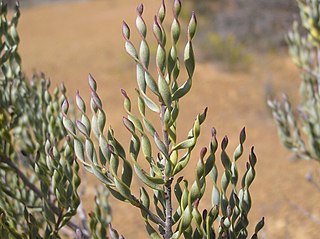
Persoonia helix is a species of flowering plant in the family Proteaceae and is endemic to the south-west of Western Australia. It is an erect to spreading shrub with hairy young branchlets, twisted leaves and bright yellow flowers borne singly or in groups of up to five on a rachis up to 25 mm (0.98 in) long.

Persoonia brevirhachis is a species of flowering plant in the family Proteaceae and is endemic to the south-west of Western Australia. It is an erect, often spreading shrub with smooth, compact bark, mostly narrow spatula-shaped to lance-shaped leaves with the narrower end towards the base and yellow to greenish yellow flowers borne singly or in pairs in leaf axils.
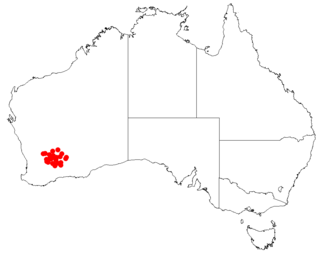
Persoonia inconspicua is a species of flowering plant in the family Proteaceae and is endemic to the south-west of Western Australia. It is an erect, often spreading shrub with branchlets and leaves that are densely hairy when young, linear leaves and relatively small greenish yellow flowers usually borne singly or in pairs.
Persoonia spathulata is a species of flowering plant in the family Proteaceae and is endemic to the south-west of Western Australia. It is an erect to spreading shrub with hairy young branchlets, spatula-shaped leaves, and yellow flowers arranged singly or in pairs on a rachis up to 2 mm (0.079 in) long that continues to grow after flowering.
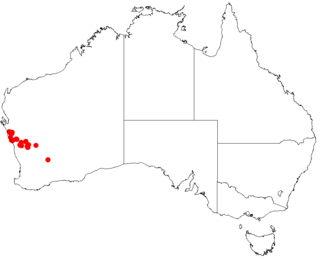
Persoonia hexagona is a species of flowering plant in the family Proteaceae and is endemic to the south-west of Western Australia. It is an erect, spreading shrub with branchlets that are densely hairy when young, linear, sharply pointed leaves and bright yellow, hairy flowers borne singly or in groups of up to ten on a rachis up to 40 mm (1.6 in) long.
Persoonia bowgada is a species of flowering plant in the family Proteaceae and is endemic to the south-west of Western Australia. It is an erect to spreading shrub with smooth bark, more or less cylindrical leaves and yellow flowers in groups of up to ten on the ends of branches.
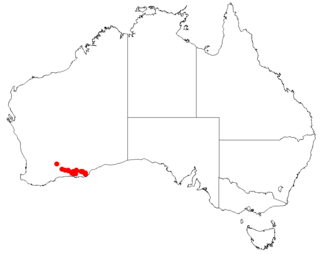
Persoonia cymbifolia is a species of flowering plant in the family Proteaceae and is endemic to the south of Western Australia. It is an erect, spreading shrub with smooth bark, hairy young branchlets, linear to narrow oblong leaves and yellow flowers borne singly or in groups of up to three on a short rachis.
Persoonia leucopogon is a species of flowering plant in the family Proteaceae and is endemic to Western Australia. It is an erect to low-lying shrub with branchlets that are densely hairy when young, narrow oblong to narrow elliptic leaves and yellow or greenish yellow flowers borne singly or in groups of up to four on a rachis up to 2 mm (0.079 in) long.
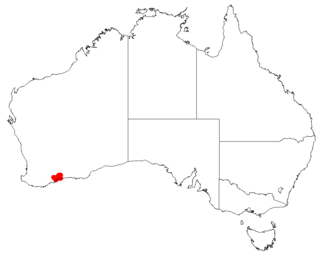
Persoonia dillwynioides, commonly known as Fitzgerald persoonia, is a species of flowering plant in the family Proteaceae and is endemic to a restricted area in the south-west of Western Australia. It is an erect, spreading shrub with smooth bark, linear leaves and bright yellow flowers borne singly or in groups of up to four along a rachis up to 3 mm (0.12 in) long.
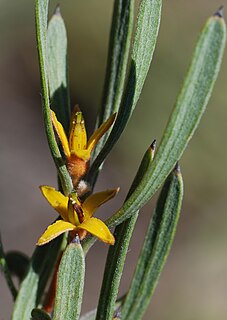
Persoonia trinervis is a species of flowering plant in the family Proteaceae and is endemic to the south-west of Western Australia. It is an erect, sometimes spreading shrub with densely hairy young branchlets, spatula-shaped or lance-shaped leaves with the narrower end towards the base, and densely hairy yellow flowers.
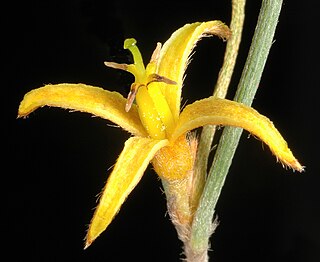
Persoonia angustiflora is a species of flowering plant in the family Proteaceae and is endemic to the south-west of Western Australia. It is an erect shrub with hairy branches and leaves, linear, more or less cylindrical leaves and yellow or greenish yellow flowers arranged singly or in groups of up to four.
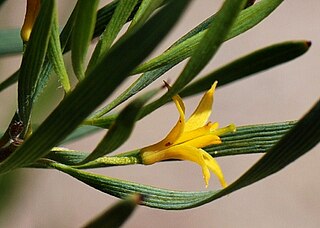
Persoonia quinquenervis is a species of flowering plant in the family Proteaceae and is endemic to the south-west of Western Australia. It is an erect, spreading shrub with hairy young branchlets, twisted linear, lance-shaped, narrow oblong or narrow spatula-shaped leaves, and bright yellow flowers borne in groups of up to ten on a rachis up to 60 mm (2.4 in) that continues to grow after flowering.

Persoonia filiformis is a species of flowering plant in the family Proteaceae and is endemic to the south-west of Western Australia. It is a small, erect shrub with hairy young branchlets, linear leaves and greenish yellow flowers borne singly or in groups of up to twenty on a rachis up to 30 mm (1.2 in) long.
Persoonia biglandulosa is a species of flowering plant in the family Proteaceae and is endemic to the south-west of Western Australia. It is an erect, spreading or low-lying shrub with smooth bark, linear leaves and bright yellow flowers in groups of between eight and twenty-five on the ends of branches.
Persoonia brachystylis is a species of flowering plant in the family Proteaceae and is endemic to a restricted area on the west coast of Western Australia. It is an erect, spreading shrub with smooth bark, narrow spatula-shaped to lance-shaped leaves and yellow flowers in groups of ten to twenty.

Persoonia stricta is a species of flowering plant in the family Proteaceae and is endemic to the south-west of Western Australia. It is an erect, spreading shrub with smooth bark, linear to spatula-shaped or oblong leaves, and bright yellow flowers borne in groups of four to twenty-five on a rachis 3–100 mm (0.12–3.94 in) long, each flower with a leaf or scale leaf at its base.

Persoonia teretifolia is a species of flowering plant in the family Proteaceae and is endemic to the south-west of Western Australia. It is an erect, spreading shrub with smooth bark, hairy young branchlets, linear leaves, and bright yellow flowers borne in groups of up to twenty on a rachis up to 100 mm (3.9 in) long that continues to grow after flowering.
Persoonia hakeiformis is a species of flowering plant in the family Proteaceae and is endemic to the south-west of Western Australia. It is an erect or spreading to low-lying shrub with mostly smooth bark, linear leaves and bright yellow flowers borne in groups of up to sixty along a rachis up to 100 mm (3.9 in) long.













